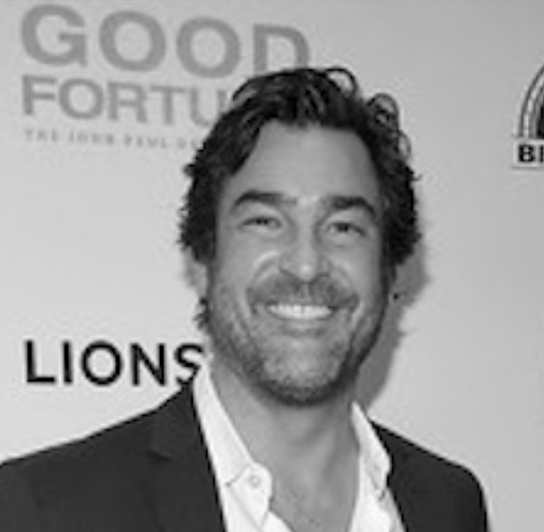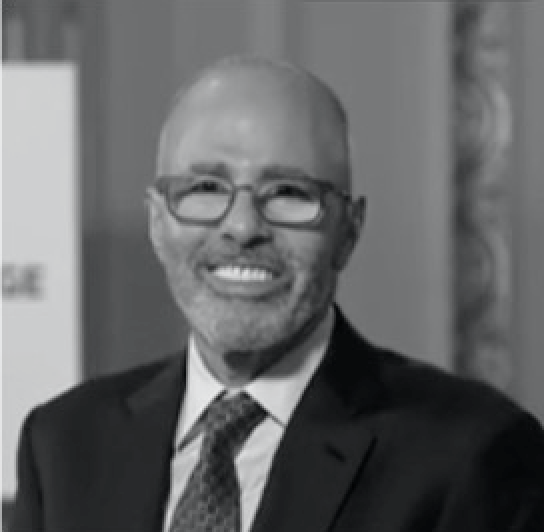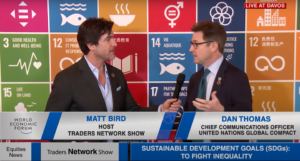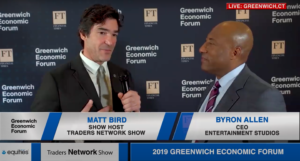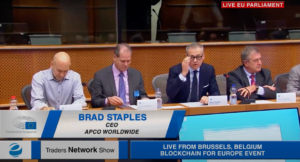Frank Ricotta, Kenneth Colon and Wendy Charles on ‘Blockchain in Healthcare’ at Converge2Xcelerate | Traders Network Show – Boston, MA
Contributed by: Show Editorial Team
Frank Ricotta, CEO of BurstIQ, Kenneth Colon, Director of Marketing & BD at Orderly Health, and Wendy Charles, Regulatory Scientist at Denver Health at Converge2Xcelerate Conference (Boston, MA)
HIGHLIGHTS
- Blockchain technology in healthcare market expected to reach $42.1 million by 2023
- In first 12 months of operation, BurstIQ platform processed 25 billion data points
- Over 50% of healthcare provider records are inaccurate
FULL COVERAGE
INTERVIEW TRANSCRIPTS: Frank Ricotta, CEO/Co-Founder of BurstIQ, Kenneth Colon, Director of Marketing & BD at Orderly Health, and Wendy Charles, Regulatory Scientist at Denver Health
Frank Ricotta – CEO/Co-Founder, BurstIQ: 00:00
For the sake of time, we’re just going to jump right into to providing an overview and I’ll let my distinguished panelists introduce themselves when they come up to the podium to talk about their use case. So again, the three of us again, Frank Ricotta, CEO of BurstIQ, Wendy Charles with Denver health and University of Colorado and Ken Colon with Orderly Health.
Frank Ricotta – CEO/Co-Founder, BurstIQ: 00:31
Okay. Blockchain applications. There’s a lot of conversation about where blockchain fits in health and this is just a smattering of a number of use cases that we know there are active projects out in the world in terms of trying to leverage blockchain to solve some of these aspects. And there are a number of solutions in production that cut across a broad spectrum of health. I think it’s important to note that health isn’t just one segment. Health is a lot of segments from large hospital systems on one side of life to doctors, to clinical research organizations, biotech, pharma, supply chain as well as insurance than the payer side of life. So health is a multi trillion dollar industry. So lots of opportunity for innovation and improvement. But at the end of the day you know, what, what is the foundational problem, at least I think the usher in the next generation health.
Frank Ricotta – CEO/Co-Founder, BurstIQ: 01:26
And that is really, data. Data is a foundational use case. Everybody talks about data being valuable. Absolutely is valuable. You know, researchers really are demanding more of it. Companies are created every day to generate very variations of data about you. And yet we as individuals can access, don’t understand it. Let alone can use it each and every day. And let’s not forget that it’s very valuable. Bad folks sinks. It think it’s very valuable. One out of three individuals in this room probably had elements of their health record compromise over the last couple of years. But the reality to usher in the next generation of health, one that truly is person centric, that’s an everyday all the time thing for care, for health, for life. It’s really all about data and creating these longitudinal health profiles with individuals. So with that, I’m going to jump into what is an identity or a health profile?
Frank Ricotta – CEO/Co-Founder, BurstIQ: 02:22
Well, if you think about it, it’s not just you know, your name as an example. There are at the station attributes about your identity that make up who you are. If you’re a doctor, our facility per person places and things, it could be an MPI, a government ID, a health record, a bank account, fitness data and a whole host and other attributes that really make up not only your identity but your overall health profile. There are three parts to identity at least to the attributes that are attached to identity. One are claims and they can be made by the person or the business themselves or the entities said, this is who I am. Other ones are proof which proves which are evidence of that claim. It could be say my, my degree from the university I attended a driver’s license, a passport that I provided a copy of to validate who I am.
Frank Ricotta – CEO/Co-Founder, BurstIQ: 03:15
So these are proofs associated with my ID. The third one is at testation which is a validation of the proof. Where did it come from? Did it come from the government or in the case of credentialing, say for a physician, do I have a third party? Validate the proofs and the claims associated with that, that particular physician. So all three go together to make up an identity. And really it’s about what Ty, what part of the data are you trusting? The other aspect which is consent and what aspect of the data I’m going to, I’m going to share and in what capacity and for how long and could be fully anonymous. I go to the store as an example and I want to buy a candy bar. I pay with cash. The clerk doesn’t know who I am. If I’m buying a car or a house and they want to know a lot about who I am, especially if I’m asking for a loan to purchase that item and I’m giving you a use case outside of health.
Frank Ricotta – CEO/Co-Founder, BurstIQ: 04:12
But really we should have the ability to control the how our personas are presented out into the world and who can see what. So at the end of the day, it’s about granular consent, you know, and we see a lot of legislation really put pushing the whole topic of consent and giving the owner of the data or the person more control of who’s using their data, particularly on the consumer side of life. And we’ve had a lot of regulatory oversight particularly the health care side of life. But you’re really seeing a lot of this regulatory guidance and push across, not just Europe but throughout the United States. So the ability to have a framework and an infrastructure that provides for granular consent and sharing around an identity of a person, place or things. Pretty important. And this is foundation to a lot of our use cases at least at BurstIQ. One being EID initiatives and smaller just a sovereign jurisdictions outside of the United States. We’ve been teaming with the know your customer and any Monday laundering blockchain company called shift and have a number of active deployments underway with them where we’re storing the claims in our test stations and they’re providing the transactional framework for access to the identity. I’m going to now shifted over shifted over to Ken and let him pick it up with blockchain and machine learning for provider data.
Kenneth Colon – Director of Marketing & BD, Orderly Health: 05:49
Awesome. Thank you so much Frank. My name’s Kenneth Colon. I head up product and marketing at orderly health. We’re a machine learning startup based in Denver and we work with health insurance companies to help them improve the accuracy of their provider directories. So as Frank talked about you know, identity and profiles are a huge challenge for healthcare. And so I want to talk to you today specifically about provider profiles. So when we say provider data, I think it’s important to kind of clarify what exactly we talking about. So when we’re referring to provider data, typically we’re looking at say a providers contact information. So say phone and address. For a primary care provider. We’re also talking about their professional information. So their specialty any certification or license numbers associated with that provider, their network status for a particular insurance company.
Kenneth Colon – Director of Marketing & BD, Orderly Health: 06:37
So, you know, what networks are they in network with which experiences do they accept? And lastly, panel status. So are they currently accepting new patients? And this can get a little more, can get a little more granularly with this and go down to the level of, are they accepting new Medicare, Medicaid patients? Are they accepting new commercial patients? And so this is kind of what we focus on at Orderly Health. And what is kind of the status quo with provided data currently? So health plans are spending over 2 billion annually trying to solve this problem and they’re not doing a very good job. So according to a recent study by CMS, about 50% or more of provider directories have sorry, 50 or more percent of provider records aren’t accurate. So for any particular doctor has about a 50, 50 chance that one aspect of their record will be inaccurate, whether that’s whether they’re in network with your insurance, whether that’s their contact information, there’s a 50% chance at some aspect of their record isn’t accurate as resulting from this one in seven patients receive a surprise bill due specifically to inaccurate network information.
Kenneth Colon – Director of Marketing & BD, Orderly Health: 07:44
So I had experienced this personally. You know, you go to a provider and make an appointment thinking that they’re a network. The provider themselves might even say they’re a network, but according to the health plan, they’re not in network. So you could build the full out of network price.
Kenneth Colon – Director of Marketing & BD, Orderly Health: 07:58
So regulators, especially focusing on that surprise billing issue are starting to crack down on this. So health plans can face not only federal fines of up to $25,000 per beneficiary. They could also receive or be mandated to reimburse patients. So if you unknowingly go to a doctor who is not in network, the health plan might be forced to reimburse you for the cost of that care. There are also been instances of blocks place on new enrollment. So if a particular health plans director is particularly inaccurate CMS may place a block on new enrollments for that program until their accuracy gets above a certain threshold. So to tackle this at orderly health Oh, excuse me, sorry, I didn’t change the slides here. So to tackle this already a health, we use a mixture of data and machine learning essentially. So we source over 1 billion data points from both public and proprietary sources and we combine that with our machine learning engine. And what we’ve been able to do there is deliver accuracy of 90% or more for health plan clients. So it’s taking them from, you know, the average baseline of 50% all the way up to 90 or more. And we’re doing this at a 74 75% or greater cost savings for health plan clients. This especially compared to more traditional models of or more traditional methods of validating the data, which is typically things like call centers.
Kenneth Colon – Director of Marketing & BD, Orderly Health: 09:21
But we still faced a lot of issues with that. One of the three big questions we would get from our health land clients is how do we securely store this data? How do we manage sharing of this data and how do we create an audit trail for regulators? That last point is especially critical as CMS would often go to our health line clients and ask them, you know, okay, you have the certain level of accuracy, but how do we see how it’s changed over time? And so, you know, those areas aren’t necessarily, you know, areas that we ourselves dabble in, but we recognize it as really important for this for our health plan clients. And so that’s where our partnership with BurstIQ came in. And so Frank and his team at BurstIQ have developed this really robust blockchain platform. And so our companies kind of came together and launched this joint solution focused on provider data to address some of those concerns that our health plan client set. So with the blockchain you get the security aspect.
Kenneth Colon – Director of Marketing & BD, Orderly Health: 10:21
You get the security piece, which I think a lot of us here in this room know about the security benefits of the blockchain. With the burst IQ platform, you get the sharing aspect, so manage consent. So the health plan can manage who has access to that data. Lastly, you get the accuracy piece through our machine learning engine. Sorry, excuse me. And then lastly, you’ve got the audibility piece. So every time we’re updating a record we append it to the BurstIQ chain so that regulators at CMS and others can see how the data has been changed and updated over time. And so that does it for provider data. And I will now turn it over to Wendy Charles to talk through data aggregation in a clinical health data organizations. Thank you so much.
Wendy Charles – Regulatory Scientist, Denver Health: 11:16
Hello everyone. I’m Wendy Charles and it’s such a pleasure to be with you today. I have seen many presentations in the past about potential use cases and so it’s a joy for me to talk to you about a case that’s in production, very successful and was a huge news in Denver when it was first released. So to start out, give you the setting about this use case. There are three clinical health data organizations in the Denver area that are required to produce quality metrics for state run federally qualified health programs. So the Colorado regional health information organization, which I’ll call choreo throughout the presentation is a health information exchange comprised of 5 million individual patients, about 80% of the Denver area, 74 hospitals, and has 12,000 physician users that login. The quality health network is a health information exchange on the Western side of Colorado, which involves 14 hospitals and 95% of the physician providers and the Colorado community managed care network is a, an organization of clinics and about 50% of the Medicaid patients that are served by that network.
Wendy Charles – Regulatory Scientist, Denver Health: 12:38
And it, there was a need to share these quality metrics with this state of Colorado in an aggregate format from these three organizations. And I don’t know about the types of technologies that your healthcare organizations use, but I was speaking with a programmer about two weeks ago who said that he serves a hospital in Idaho that prepares its quality metrics using a DOS-based system. So there’s real need to have appropriate technology and to have an opportunity to share the aggregated information with the state of Colorado as well as protecting data confidentiality. And one of the primary goals is to reduce the administrative costs and burdens of aggregating these quality metrics.
Wendy Charles – Regulatory Scientist, Denver Health: 13:34
So in August of 2018 these three data organizations partnered with BurstIQ and put the quality metrics on the BurstIQ blockchain. This particular project was an initiative funded by the Colorado state innovation model program, which itself is funded by the centers for Medicare and Medicaid. And this was a first of its kind project and partnership in Colorado. So this slide shows among these organizations that are connected. There’s true data liquidity between endpoints, stakeholders and systems. And it’s valuable to note that of the end points. It can include a data input and points as well as data visualization tools. And so how it works. You’re familiar with blockchain, you’re comfortable already with the nature of interoperability. But one of the points on this slide that I had wanted to draw attention to is that the data sharing among these health organizations could take place without revealing individual data points to each other. And so the analysis could take place as if all of the datas were aggregated and but each individual organization could only see its own information. And as Frank mentioned earlier, one of the features of blockchain that really helps with health information exchanges is the complex ownership and the granular consent. And having come from a background of clinical research, the consent portion is very important to me as and when GDPR was introduced, granular consent was a major component to duty PR because you cannot simply consent to a batch of potential opportunities. You have to be aware of each one individually or to the degree at least that a reasonable person would make their conclusions.
Wendy Charles – Regulatory Scientist, Denver Health: 15:37
And the blockchain does automate the permissible access and the data uses. So the preliminary results is that it is reducing administrative burdens of aggregating these clinical quality metrics. It’s much simpler to extract and report. And of course using the blockchain and having more control over privacy, there is better confidentiality. So initially there were some questions about jurisdiction and the need for governance. These are the same types of questions that come up with implementation of many different types of blockchain solutions. And because blockchain is a newer solution to address health information, it was necessary to educate stakeholders and the community about what blockchain is and what it isn’t so that they were much more comfortable with the solution. So we see a tremendous amount of future potential beyond the current uses. And part of this will be to create a data ecosystem across other state agencies or health service providers as well as more consumer directed data sharing options.
Wendy Charles – Regulatory Scientist, Denver Health: 16:53
As both Frank and Ken mentioned about giving patients more control. And the I’m very hopeful that there will be more opportunities for research and public health surveillance because if you can perform analysis without access to the individual data points, it provides another layer of confidentiality. And in many other sessions I’ve heard this morning too, there’s a lot of concern about re-identification and Latanya Sweeney is a Harvard professor who has done a tremendous amount of re-identification research and showed that even when we think our data sets are de identified using the power of much more powerful computing and publicly available records, it is increasingly common to be able to re-identify participants. So the more protections we can put in place for limiting access to the actual data points, the stronger the protections will be. That’s the end of my presentation. Okay, thank you.
Frank Ricotta – CEO/Co-Founder, BurstIQ: 17:58
So I’m just going to wrap it up. I know we’ve focused on a couple of our validated use cases. As I said, we’ve been in production now for a year and a half. What I want to emphasize though is not just, it’s not about blockchain in reality, just like any innovation, adoption is never really about the technology. It’s about what you’re enabling your clients to do. Is it doing something new or improving what they’re doing or taking costs out of, out of their current operational mode. So when we started down the path and we mentioned blockchain, we got crazy looks, what the heck is that? And then it started to become, a word in Vogue and think of the cloud adoption years ago. Are you going to the cloud? Yes, I’m going to the cloud. Where’s the cloud?
Frank Ricotta – CEO/Co-Founder, BurstIQ: 18:43
I don’t know where the cloud is, but I’m definitely going to be on the cloud at some point in time. So that’s where you see a lot of the traditional health clients really sit today. They know it’s important. They know potentially can change things for them. But when you start wrapping solutions around it and making the blockchain stuff easy and solving real problems that can’t be solved with traditional technologies, you’ll get it out of the spectrum of somebody saying, well, why is it different than a database? You’ll see, they’ll start seeing the potentials and the opportunity to change what they’re doing and to create even new revenue or care models. And I think that’s what we’re really all about. So again, make it simple for people you know. Hi, I am I my view, hide the technology of block to any geeks. I’ll get it, but you really want the business users to get it. Hey, thanks for your time today. Really appreciate everything and have a have a great afternoon.
For Link to Original Article, Click Here
All rights reserved to the Traders Network Show. No part of this publication may be reproduced, distributed, or transmitted in any form or by any mean including; photocopying, recording, or other electronic or mechanical methods, without prior written permission of the publisher, except in the case of brief quotations embodied in critical reviews and certain other noncommercial uses permitted by copyright law. For permission requests, write to the publisher addressed “Attention: Permissions Coordinator”

